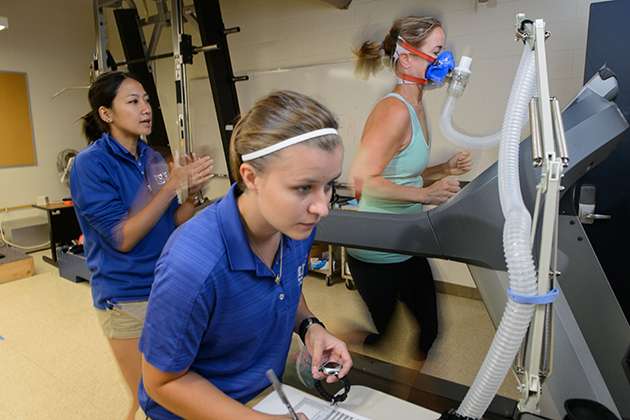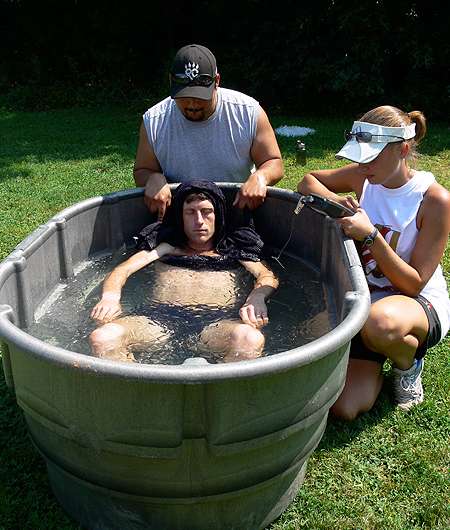Keeping runners safe in summer heat

The New Balance Falmouth Road Race is one of the premier running events of the summer season, drawing an estimated 75,000 spectators, who strain to catch a glimpse of Olympic-caliber runners as they tear through a scenic seven-mile seaside course in the sweltering summer heat.
The race from Woods Hole, Mass. through the flats along Martha's Vineyard Sound to Falmouth Heights Beach can also be dangerous.
A volatile mix of heat and humidity, the race's short distance, and the tendency for high-intensity competitive athletes to push themselves to the extreme invites trouble, if the runners aren't careful.
The Falmouth runners aren't alone. Thousands of competitive runners face similar challenges in summer races across the country each year.
UConn kinesiology professor Douglas Casa, chief operating officer for the University's Korey Stringer Institute (KSI), has been working the Falmouth race for the past 14 years and will be there again on Aug. 16, when more than 12,500 runners gather at the starting line.
The Korey Stringer Institute is dedicated to the prevention of sudden death in sport, and is considered a national leader in research on exertional heat stroke. The institute has been conducting research at the Falmouth race since 2013.
Casa says Falmouth race officials are exemplary in their attention to athlete safety and their ongoing support of research that is advancing understanding and treatment of exertional heat stroke.
"We have such an amazing opportunity at Falmouth," says Casa, who suffered an exertional heat stroke as a teenage competitive runner in 1985. "These race officials deserve a lot of credit. This race is single-handedly advancing medicine so much faster than we would ever be able to do working solely in the lab."
The Falmouth studies produced by KSI researchers represent some of the largest and most comprehensive in the field in terms of the number of actual cases of heat stroke reviewed.
At least one runner in every 1,000 entrants in the Falmouth race suffers a potentially deadly exertional heat stroke, according to KSI researchers – an incident rate 10 times higher than that reported at cooler races in the spring and fall. Since 1984, more than 270 cases of exertional heat stroke have been reported at the Falmouth race.
Casa is proud of the fact that no runner has ever died in Falmouth who was treated at the race's on-site medical tent where staff follow his mantra – "Cool first, transport second" – in their treatment protocols. Death from exertional heat stroke is 100 percent preventable, he says, if a person is immersed in a cold water ice bath within minutes of the illness's onset.
Exertional heat stroke is one of the leading causes of deaths among athletes and is characterized by a body temperature greater than 104 degrees Fahrenheit and central nervous system dysfunction ranging from headaches and confusion to altered states of consciousness, vomiting, and collapse.
In-depth research
Joining Casa in Falmouth this year will be a team of nearly 30 researchers, athletic trainers, medical professionals, and students, almost all of them affiliated with UConn. Some of the team will be supporting on-site medical staff with race triage, while others will be gathering blood samples, medical information, and other data for three scientific research studies related to heat stroke.
One of those studies, led by the KSI's assistant director of research Rachel Katch, is looking at whether athletes who train in warm weather conditions up to four weeks prior to a race perform better in hot weather races than athletes who are less acclimatized.
The second study, conducted by KSI vice president of operations and education Rebecca Stearns and KSI staff member Luke Belval, will track heat stroke survivors to see what physiological conditions may have precipitated the heat stroke, and what health concerns the survivors encounter in their long-term recovery.
"We hope this study will be beneficial to athletic trainers, exercise scientists, and medical professionals," says Yuri Hosokawa, director of communication and education at KSI. "There is very sparse evidence right now that dictates when and under what conditions someone can return to activity after having an exertional heat stroke."
The third study will look at runners' RNA and DNA to check for the presence of possible genetic biomarkers that could be associated with an athlete's ability to tolerate and perform well in high temperatures. UConn assistant professor of kinesiology Elaine Choung-Hee Lee, Hosokawa, and Katch are investigators on this study, along with Casa.
The genetic study is part of a larger investigation being conducted by KSI researchers into a medical malady known as malignant hyperthermia. Malignant hyperthermia is a potentially fatal, inherited disorder usually associated with the administration of certain general anesthetics and/or the drug succinylcholine. Some individuals also develop malignant hyperthermia through exercise and exposure to hot environments. Without proper treatment, mortality is extremely high.

The Korey Stringer Institute will host an international symposium on malignant hyperthermia in Storrs on Sept. 17 and 18.
But for now, the focus is on Falmouth.
A lab of 12,000
"The Falmouth race is an amazing opportunity for us to conduct research on two big ticket items," Casa says. "One, it allows us to work with people who have had a heat stroke because obviously we can't induce heat stroke in the lab. Second, from a research perspective, it is a race where people get really, really hot. So it's an opportunity for us to study exercise-induced hyperthermia where you basically have a lab of 12,000 people who just exerted themselves and got really hot."
Dr. John Jardine, co-medical director for the Falmouth race and now also chairman of the KSI's Medical and Science Advisory Board, says he was impressed with Casa and the KSI team when he watched them in action.
"Each year, Doug came with a larger group of volunteers," says Jardine, who is trained in emergency medicine. "I began to understand that what we were doing actually had science behind it. I studied Doug's research on heat illness, and our discussions over the years turned into new research ideas and projects."
Several athletic trainers from other states also will join the KSI team in Falmouth this year. Casa says it's an opportunity to train others and help spread the word about the importance of cold water immersion in treating heat stroke. Those who visit Falmouth bring the emergency protocols back to other races around the country.
Casa says Falmouth was "the place where that whole concept of cold water immersion came to life for athletes suffering exertional heat stroke. If we get their temperature down really fast, we don't have to worry about other issues."
















